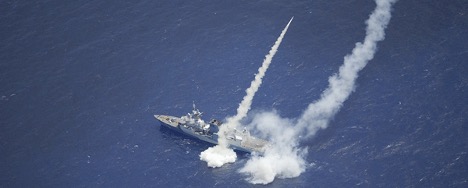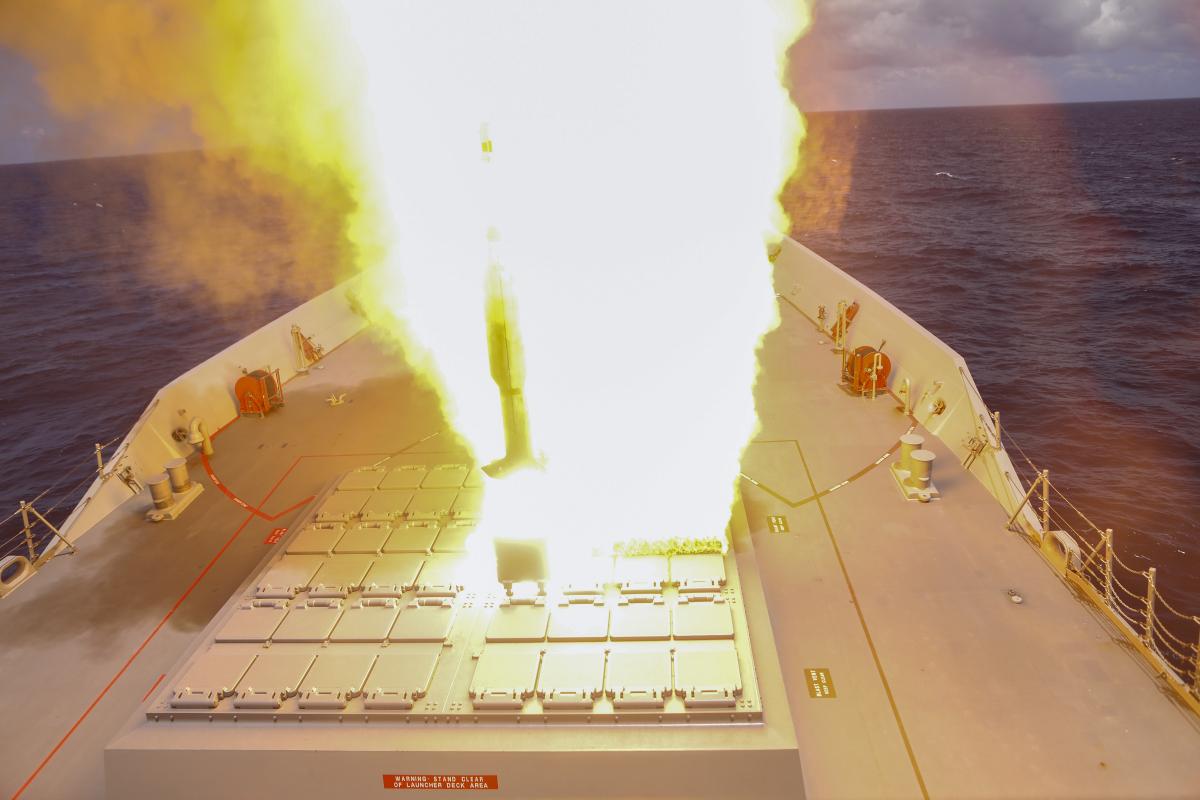Recently, this year’s RIMPAC exercise concluded.
According to a press release from the Commander, U.S. Pacific Fleet, public affairs, published on August 31, 2020:
PEARL HARBOR, Hawaii – The international maritime exercise Rim of the Pacific (RIMPAC) 2020 concluded Aug. 31 following two weeks of at-sea-only training events conducted around the Hawaiian Islands.
This year’s event included 53 replenishment-at-sea events, 101 pallets of cargo distributed, over 16,000 rounds of small arms munitions shot, over 1,000 large caliber weapons fired, 13 missiles expended, and 1,100 pounds of mail delivered.
Hosted by U.S. Pacific Fleet, RIMPAC 2020 was led by U.S. Vice Adm. Scott Conn, commander of the U.S. 3rd Fleet.
“Our formidable team of capable, adaptive partners has spent the last two weeks demonstrating that we have the resolve and ability to operate together in these challenging times,” said Conn. “We strengthened relationships and deepened our sense of trust in one another. Each one of our navies has something to offer and that diverse range of knowledge and professionalism is what makes us stronger, and allows us to work together to ensure a free and open Indo-Pacific and ultimately, our collective prosperity.”
This year’s exercise includes forces from Australia, Brunei, Canada, France, Japan, New Zealand, Republic of the Philippines, Republic of Korea, Singapore, and the United States.
The at-sea-only construct for RIMPAC 2020 was developed to ensure the safety of all military forces participating, and Hawaii’s population, by minimizing shore-based contingents, while striking a balance between combating future adversaries and the COVID-19 threat. Commander, U.S. Pacific Fleet crafted the modified RIMPAC plan as a way to conduct a meaningful exercise with maximum training value and minimum risk to the force, allies and partners, and the people of Hawaii.
This RIMPAC marks the first time a non-U.S. military woman, Capt. Phillipa Hay of the Royal Australian Navy (RAN), led a RIMPAC task force of more than 2,500 Sailors.
“I would like to extend my sincere appreciation and thanks to all participating nations in RIMPAC 2020. Our mutual commitment toward a free and open Indo-Pacific will ensure unfettered open access to the seas and airways upon which our people and economies depend, now and into the future,” said Adm. John C. Aquilino, commander, U.S. Pacific Fleet.
The biennial exercise contributes to the increased lethality, resiliency, and agility needed by the Joint and Combined Force to deter and defeat aggression by major powers across all domains and levels of conflict. The exercise provides a unique training opportunity that strengthens international maritime partnerships, enhances interoperability, and improves the readiness of participating forces for a wide range of potential operations. The relevant, realistic training program included multinational anti-submarine warfare, maritime intercept operations, and live-fire training events, among other cooperative training opportunities.
A Canadian Perspective
In an posting published by Front Line Defence on September 2, 2020, the Canadian role was highlighted by Ken Pole.
This year’s biennial two-week Exercise Rim of the Pacific (RIMPAC) has finished off with a bang. In fact, lots of bangs that resulted in the sinking of a ship.
Royal Canadian Navy (RCN) frigates HMCS Regina and Winnipeg were among 22 surface vessels from around the world, one submarine, and several aircraft, all conducting interdiction and anti-submarine warfare exercises as well as live-fire training for two weeks off Hawaii.
Each RCN ship deployed its Sikorsky CH-148 Cyclone helicopter several times, the first time they have been used in the unique training exercise, the largest of its kind in the world.
Unlike previous RIMPACs, the 2020 edition, with 500 Canadians among the approximately 5,300 personnel, was conducted entirely at sea due to concerns about COVID-19. It was the 27th RIMPAC for Canadian Armed Forces personnel, who were involved in the inaugural exercise in 1971 along with Australian and U.S. forces.
In addition to the Canadians and host U.S. Pacific Fleet ships and personnel, the other participants were Australia, Brunei, France, Japan, South Korea, New Zealand, the Philippines and Singapore.

The RCN Commander, VAdm Art McDonald, pointed out that “Canadian security and prosperity rely increasingly on our relations in the Asia-Pacific,” adding that Canada’s long-standing participation “highlights our ongoing commitment to […] peace and stability in the region.”
An operational highlight, two days before RIMPAC 2020 concluded on 31 August, was the sinking under heavy fire of a decommissioned US Navy amphibious cargo ship, USS Durham, which was rendered environmentally safe for the SINKEX event.
The SINKEX ended shortly after midnight, courtesy of a Mk-48 torpedo fired by USS Jefferson, a Los Angeles-class attack submarine, as well as an AGM-114 Hellfire missile fired by a USN helicopter and two Harpoon AGM-84 surface-to-surface missiles, one of them from HMCS Regina.
“We gained invaluable training experience, improved our ability to operate in a coalition environment, proved key combat capabilities and fostered trust amongst allies and partner navies while ensuring the health and well-being of our sailors and aviators,” said the RCN Task Force Commander, Capt (N) Scott Robinson.
HMCS Regina’s weapons officer, Lt(N) Mike Vanderveer, said the SINKEX not only proved the frigate’s technical readiness but also was “an opportunity to focus on the application of force in coordinated kinetic action with partner nations.”
Harpoons are designed to travel at high subsonic speed, skimming the ocean’s surface to reduce the chance of interception by air defence systems. Using the over-the-horizon missile, which is widely deployed within NATO, is “a difficult and perishable skill,” Vanderveer said. “Any opportunity to plan and execute exercises with combined forces increases our skills, proficiency, and overall capability.”
RIMPAC provides a wide range of unique training opportunities that allow participating naval personnel to put their respective skill sets to the test.
Having completed RIMPAC 2020, the next phase of HMCS Winnipeg’s deployment will be participation in Operation Projection Asia-Pacific, which demonstrates Canada’s ongoing commitment to global peace and shows how the RCN is ready to defend Canada’s interests in the region.
Australia’s HMAS Hobart Participates in RIMPAC 2020
In an article published on August 27, 2020 by Lt. Commander Todd Fitzgerald of the Royal Australian Navy, the Hobart’s participation in the exercise was highlighted.
HMAS Hobart has become the first Hobart-class guided missile destroyer to conduct a live fire at Exercise Rim of the Pacific, making it the most sophisticated and lethal warship ever operated by the RAN.
Alongside ships from the United States and Canada, Hobart successfully fired an SM-2 against an unmanned target as part of the exercise scenario.
Commanding Officer Hobart Commander Ryan Gaskin said the missile firing proved the ship was ready to fight and win at sea as part of a joint force.
“Rimpac provides Navy with a unique training opportunity to strengthen international maritime partnerships, enhance interoperability and improve our readiness for a wide range of potential operations,” Commander Gaskin said.
“This year has also proven the ability to operate in company with partner nations at sea during a global health crisis through the employment of strict COVID-19 safe measures on board.”
HMA Ships Hobart, Stuart, Arunta and Sirius, which are on a Regional Presence Deployment through South-East Asia and the Pacific, are taking part in Rimpac.
Commander Gaskin said credible, ready-maritime partners helped to preserve peace and prevent conflict in the region.

“The Indo-Pacific has experienced economic prosperity largely because of the security and stability that exists at sea,” he said.
“We train to ensure the ability to deter disruptions to global supply chains and threats to lines of communication and commerce.”
Hobart carries a range of weapons systems, including an Mk41 Vertical Launch System containing SM-2 missiles and Evolved Sea Sparrow missiles, an Mk 45 5-inch main gun, Phalanx Close-In Weapons System, two 25mm Typhoon guns, and MU90 and Mk54 light-weight torpedoes for subsurface defence.
Ten nations, 22 surface ships, one submarine, multiple aircraft, and about 5300 personnel are participating at Rimpac.
This year’s exercise includes forces from Australia, Brunei, Canada, France, Japan, South Korea, New Zealand, Philippines, Singapore, and the United States.
Participating forces will exercise a wide range of capabilities from multinational anti-submarine warfare, maritime intercept operations, and live-fire training events, among other cooperative training opportunities.
ANZAC-Class Frigates at RiMPAC 2020
In an article by Lt. Commander Todd Fitzgerald published on August 31, 2020, the participation of HMAS Stuart in the exercise was highlighted as well.
The Royal Australian Navy has proven its warfighting capability with devastating effect at Exercise Rim of the Pacific (RIMPAC).
Anzac-class frigate HMAS Stuart successfully fired two Harpoon missiles and coordinated the missile firings of three other ships during one of RIMPAC’s best-known serials called the SINKEX, where participants sink a decommissioned warship.
Two of the Navy’s Fleet Air Arm MH-60R Romeo helicopters embarked in HMA Ships Hobart and Arunta also fired Hellfire missiles during the training serial on August 29.
Gunnery officer in Stuart, Lieutenant Naomi Muir, said live-fire training was critical to ensure Australia maintained a highly capable, agile and lethal fleet.
“It is critical we test our systems to their full capacity,” Lieutenant Muir said, “not only to ensure we are familiar with how our systems operate but also how we operate those systems with other navies.
“Simulation is a critical part of our training but there is nothing better than to conduct live-fire training to ensure our systems work effectively with other nations, and that our people know how to use them.”

Able Seaman Electronics Technician Callum Fox is the Fire Control Officer in Stuart, responsible for pushing the button that ultimately launches the missile.
AB Fox said Stuart had trained to fire the missile since leaving Australia in July.
“Events like these allow us to prove that we are capable of high-end warfare with allied nations. They also allow us to prove our systems and training, and prove to the Australian Government and public that we are a professional and capable navy,” he said.
Ten nations, 22 surface ships, one submarine, multiple aircraft, and about 5300 personnel have participated in RIMPAC this year.
Alongside HMA Ships Hobart, Stuart, Arunta and Sirius, the exercise has included forces from Brunei, Canada, France, Japan, South Korea, New Zealand, the Philippines, Singapore and the United States.
Participating forces have exercised a wide range of capabilities including multinational anti-submarine warfare, maritime intercept operations and live-fire training events.
Featured Photo: PACIFIC OCEAN (Aug. 21, 2020) Multinational navy ships and a submarine steam in formation during a group sail off the coast of Hawaii during Exercise Rim of the Pacific (RIMPAC) 2020, August 21. Ten nations, 22 ships, 1 submarine, and more than 5,300 personnel are participating in Exercise Rim of the Pacific from August 17 to 31 at sea around the Hawaiian Islands. (U.S. Navy photo by Mass Communication Specialist 1st Class Rawad Madanat)


